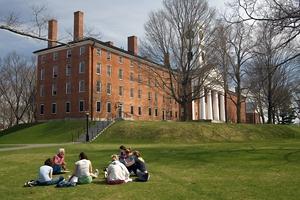April 6, 2011
For demonstrating good stewardship in the recent renovations of many of its residential buildings, Amherst College is one of 19 educational institutions in the state soon to be honored with a 2011 Paul E. Tsongas Award from Preservation Massachusetts (PM), a nonprofit organization “dedicated to preserving the Commonwealth’s historic and cultural heritage.” The award “recognizes those who have played an extraordinary role in promoting the preservation of our Commonwealth’s past for the benefit of the future.” While the majority of the other schools have won on the basis of particular single-building preservation projects, Amherst's recognition is for overall stewardship over time.
 |
“This year’s awards set out to recognize and honor Massachusetts colleges, universities and preparatory schools that have utilized and embraced preservation into their educational identity in a variety of ways,” wrote James W. Igoe, president of PM, in a congratulatory letter. “Amherst’s commitment to maintaining their historic campus showcases the incredible work and dedication of your firm and serves as a model for other colleges and universities to emulate.”
According to Tom Davies, the college’s assistant director of facilities and director of design and construction, a board member of PM became aware of Amherst’s ongoing stewardship efforts when Davies gave a presentation on the topic of sustainable preservation at a Northeast Sustainable Energy Association conference in 2009. (The college’s recent significant progress in energy efficiency is proof that “preservation and sustainability can co-exist,” he added.) At the board member’s encouragement, the staff of the college’s Design and Construction Department then prepared an application for the Tsongas Award.
The team highlighted the recent renovation and reconstruction of 18 campus buildings as part of the Residential Master Plan—emphasizing the care taken to preserve the historical character and beauty of each structure while making it safer, more environmentally friendly, more energy-efficient and more accessible to those with disabilities. In renovating Morrow Dormitory, for example, the builders set up “atypical sprinkler systems” so that the dorm could conform to modern fire-safety codes without sacrificing its oak-paneled lobby and iron staircase. The antique chestnut flooring of the renovated North and South College buildings was recycled from the original buildings’ attic framing. And during the renovation of Seelye House, “it was discovered that each of the existing corinthian columns and one of the corinthian capitals on the front porch were severely water damaged,” the team’s application for the award reads. “The existing damaged capital was removed and a plaster cast was made off site. A new cedar capital was constructed from the cast, to match the existing three capitals. The new capital and columns were installed to match the existing construction.”
Efforts such as these inspired PM to select Amherst for the Tsongas Award, which the organization established four years ago in memory of a U.S. Senator from Massachusetts. Representatives of the winning schools will accept their awards at PM’s annual Preservation Awards Dinner in Boston on May 4. Davies and Jim Brassord, Amherst’s director of facilities, say they are likely to attend.
When asked about Amherst’s stance on preservation, Davies said that he is humbled by his department’s responsibility toward “the rich history embodied in the bricks, stones, columns, trees” of the campus. But, he also noted, “this isn’t a museum; it’s a very dynamic place with constantly evolving and often cutting-edge functional requirements. Preservation must be integrated with today’s needs and a projection of the future as well.”